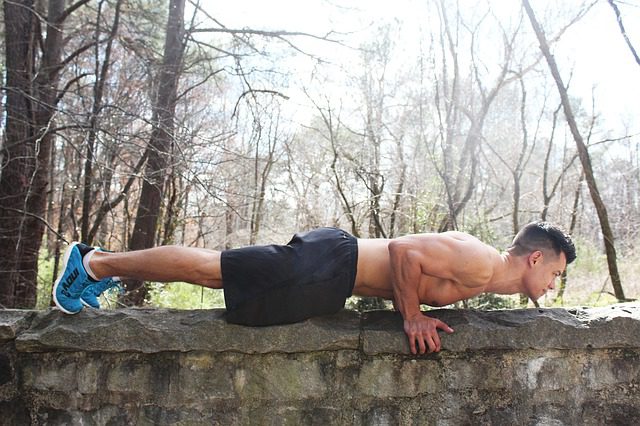Can You Make Gains Using Bodyweight Exercises?
When it comes to resistance training, not many consider bodyweight exercises as an effective way to build muscle and strength. They have this belief that you need to push around heavy weights in order to make gains or help lose body fat. Their thought process couldn’t be any further from the truth.
Those who look at various training methods know and understand that there are many different ways to activate muscle fibers and help tear them down in order to rebuild them bigger and stronger (hypertrophy). Additionally, there are many benefits to adding a variety of training programs which can include bodyweight exercises[1].
Disclaimer: This article is for informational purposes only and is not meant to treat or diagnose any condition. It is recommended that you speak with your doctor before starting any exercise program, changing your daily nutrition, or adding any supplements to your regimen.
Table of contents
6 Ways to Utilize Bodyweight Exercises
We all aren’t able to make it to the gym when life happens and we need to work late or family matters take precedence. And that’s perfectly fine. However, you don’t need to sulk over the fact that you couldn’t hit the gym because you have no excuse to NOT fit in a workout when you can utilize something such as bodyweight exercises right in the privacy of your own home.
Here are some beneficial training methods that you can use to help make gains and get in the best shape of your life by utilizing bodyweight exercises and bodyweight training.
Method 1: Time Under Tension
I’m sure many of you have heard of time under tension (TUT). Simply put, this means you need to move slowly through the full range of motion rather than moving the weight quickly. By increasing time under tension when using bodyweight exercises, you have the ability to increase the likelihood that you are breaking down more muscle fibers.
Related Article: 3 Exercises That Need to Go Away Forever

To apply this to your bodyweight exercises, slow down the movement – both the eccentric and concentric. You want to build up as much lactic acid in the muscle as possible to ensure you are creating enough metabolic stress to help stimulate muscle growth. Some people use a two-second concentric and eccentric movement. Push that out to a six-second concentric and eccentric movement to really slow it down and put the muscle under more tension over a longer period of time.
Method 2: Change the Angle of Your Bodyweight Exercises
When you think about something like chest exercises, you commonly consider exercises such as flat bench, incline, and decline. Yet, people really only consider the push-up as a means to hit your chest when it comes to bodyweight exercises. While the push-up is a great exercise when away from the gym, it’s the angles you should be focusing on to hit the various parts of the chest itself.
For instance, a plain push-up targets more of the middle of the chest. If you put your feet up on a chair and complete the same push-up, you are now targeting the upper chest. And if you flip around and put your hands on the seat of a steady and stable chair with your feet on the ground, you have the ability to target the lower section of the chest.
When completing bodyweight exercises, consider changing the angle to hit the muscle fibers differently. This can allow you to break down more fibers that aren’t normally used to being worked – especially when it comes to bodyweight exercises.
Method 3: Squeeze it Out
When you want to recruit the most muscle fibers possible, you need to learn to SQUEEZE. In order to get the most from each of your bodyweight exercises, you will want to squeeze as hard as possible at the top portion of each concentric movement. For instance, if you are doing a bodyweight squat, when you stand straight up, squeeze all of your lower body muscles as hard as possible. This means tensing your quads, hamstrings, and glutes and hold them for around two seconds.
You can also consider this technique somewhat of an isometric addition to your bodyweight exercises due to tensing the muscle for a period of time during each repetition. Combine this method with time under tension and you will feel your muscles burning quite quickly into your workout.
Method 4: Slow Down the Eccentric Portion of Bodyweight Exercises
When it comes to the eccentric portion of a movement (where the muscle lengthens), there are many techniques you can utilize. The first method you can include in your training is simply slowing down that piece of the movement you are doing. For instance, if you are doing a squat, slowly lower yourself down into the squat position by taking upwards of 10 seconds before pushing yourself back up to stand erect. Focusing on the eccentric part of the movement can help you build more muscle mass[2] in the long-run.
Another way to hit the muscle harder during the eccentric portion of the movement is to go through an entire set until you are fatigued and then focus strictly on the eccentric part of the movement. Again, using the squat as an example, you could complete your normal bodyweight set of squats utilizing a four-second concentric and eccentric. Then when you are completely fatigued, only focus on slowly lowering your body into a squat before helping to stand erect again by using an object around you such as a chair, pole, or other piece of furniture. This is a great technique to utilize at the end of a workout to truly fatigue the muscle(s).
Method 5: Pump Up the Volume
No, I’m not talking about music – even though you can if you want. But rather, what I’m referring to is increasing the total number of sets you complete for your bodyweight exercises. If you normally do 9-12 total working sets in the gym for a given body part, increase that volume to 16-20 (or any increase from your normal training volume).
Doing this is a great idea due to the fact that your body is accustomed to moving around some serious weight and in order to make your bodyweight workout comparable, you want to increase the volume to complete a comparable total amount of weight moved for a workout.

Method 6: Decrease Your Recovery Period
If you are used to taking upwards of 60-seconds as a rest and recovery period while in the gym doing bodyweight exercises, shorten that time down to 30-45 seconds between sets. When it comes to hypertrophy and building lean muscle mass, the idea is you want to push a heavy load while utilizing a short rest period. When you shorten your recovery period, it allows you to recruit different (and more) muscle fibers that have not been utilized up to that point but now are activated because your other fibers are fatigued and haven’t fully recovered.
This is a common difference when you consider rest periods for hypertrophy and strength. When trying to build strength, you actually want your muscles to fully recover before your next set. Therefore, powerlifters and those training for strength gains will tend to rest for several minutes whereas if you are looking to make some serious muscle gains, you want to keep those recovery periods short. Therefore, shorten your rest period to improve your muscle building potential.
References:
- Seguin R. A., et al. (2002). Growing stronger: strength training for older adults. Division of Nutrition and Physical Activity at the Centers for Disease Control and Prevention.
- Roig, M. et al. (2009). The effects of eccentric versus concentric resistance training on muscle strength and mass in healthy adults: a systematic review with meta-analysis. British Journal of Sports Medicine. 43(8), 556-68.


*Disclosure: This article may contain affiliate links or ads, which means we earn a small commission at no extra cost to you if you make a purchase through these links. These commissions help support the operation and maintenance of our website, allowing us to continue producing free valuable content. Your support is genuinely appreciated, whether you choose to use our links or not. Thank you for being a part of our community and enjoying our content.
PLEASE CONSIDER SHARING THIS ON YOUR SOCIAL MEDIA TO HELP OTHERS LEARN MORE ABOUT THIS TOPIC. SIMPLY CLICK BELOW!

